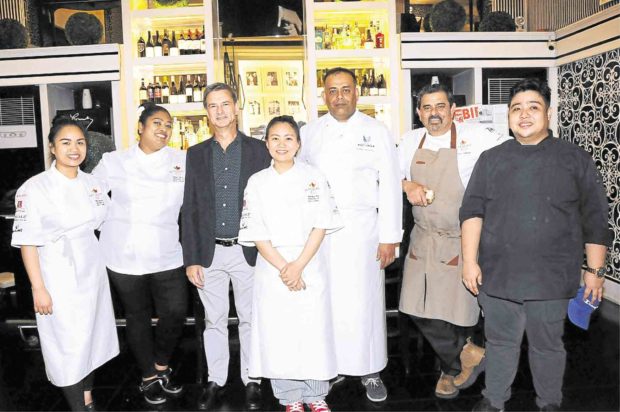
Three culinary students from the University of West London recently took a seven-day trip to the Philippines, part of their prize for winning a cooking competition this year called Zest Quest Asia. It was a special treat for the trio’s Filipino member, Mika Narciso, who came with her teammates, Marian Tandy and Bhumika Rai.
Their mission was to research on Filipino cuisine and cook at different venues, such as a charity dinner at Romulo Café in Makati, to benefit the “Foundation for Professional Training,” an Opus Dei program for women.
But the main face of Zest Quest Asia that evening was Cyrus Todiwala, one of the founders of the competition. Launched in 2013, it aims to create awareness of Asian cuisine in England, help alleviate the shortage of Asian chefs there, and encourage culinary schools to include Asian cuisine in their curriculum.
It’s funny how, even in the Philippines, we’ve been trying to ask many cooking schools to include Filipino cuisine in their curriculum. Todiwala was all encouragement about Pinoy food, describing the crackle and crunch of the lechon kawali that the team enjoyed in a Pampanga restaurant as “classy.”
We expected some Indian cooking that same evening from Todiwala, whose Café Namaste earned a Michelin Bib Gourmand, a new system that awards high-quality food at modestly priced restaurants.
Romulo’s executive chef, Aone Rebueno, and his staff, whipped up Filipino dishes for the students. It must’ve been an intensive learning experience for the student winners, since five of the seven courses were Filipino.
Three appetizers in a row consisted of kesong puti on crackers, a kinilaw of malasugui (marlin) and a rebosado (shrimp in beer batter) with a dip of crab fat aioli.
Even on that hot evening, the soup was welcoming—a clam suam, cooked in corn broth with fried chili leaves.
The salad greens were certainly Filipino—sayote tops with a fruity vinaigrette, lechon kawali bits strewn on top, and edible flowers. Sayote tops are a favorite, but they are getting too expensive—considering that sellers include the heavy, inedible stems in the weighing.
The fish course was apahap, local sea bass, which was pan-seared and served with a mango escabeche sauce.
The kamias sorbet, to cleanse the palate for the heavy main courses, was another welcome cool break.
‘Adobo’
When presenting Filipino cooking, can adobo be far behind? It came in big chicken portions, declared as a confit because it was slow-cooked, combining soy sauce and atsuete oil to the vinegar mix. and then accompanied by ginataang sigarilyas and tomatoes.
The mostly Filipino diners waited for the Goan-inspired binagoongang baboy. The menu described the process. First, the pork was marinated in a mixture of Goa red masala, vinegar and dried shrimp. Then the pieces were slow-roasted and finished with coconut milk.
The process reminded me that Goa has its own version of adobo—the vindaloo. Adlai, which was served with the pork, got the diners talking about this little-known grain that is said to be a better substitute for rice, health-wise, and needing only a little water when cultivating. But then again, adlai isn’t exactly cheap because there is less demand for it.
Dessert consisted of Filipino bibingka and the Goan bebinca. Though a bit similar in name, bebinca is made of layers of coconut, cinnamon and cardamom-flavored batter separated by ghee or clarified butter.
The conversation led to the Indian influence on Filipino cooking, most notable of which is the pickled vegetable which we call achara and Indians call achar, the same word that Warays use.
E-mail pinoyfood04@yahoo.com.